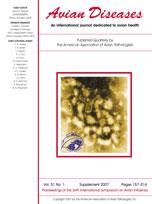In the summer of 2005 a Canadian national surveillance program for influenza A viruses in wild aquatic birds was initiated. The program involved collaboration between federal and provincial levels of government and was coordinated by the Canadian Cooperative Wildlife Health Centre. The surveillance plan targeted young-of-the-year Mallards along with other duck species at six sampling locations along the major migratory flyways across Canada. Beginning in early August, cloacal swabs were taken from 704 ducks on two lakes adjacent to one another near Kamloops, British Columbia. The swabs were screened for the presence of influenza A RNA using a real-time reverse transcription–polymerase chain reaction (RRT-PCR) assay that targets the M1 gene. Swab samples that gave positive results underwent further testing using H5- and H7-specific RRT-PCR assays. One hundred and seventy-four cloacal swab specimens gave positive or suspicious results for the presence of an H5 virus. A portion of these (28/35) were confirmed using an H5-specific conventional reverse transcription–polymerase chain reaction assay and an H5 virus was eventually isolated from 24/127 swab specimens. Neuraminidase typing revealed the presence of H5N2 and H5N9 viruses. In mid-November of 2005 an H5N2 virus was detected in a commercial duck operation in the lower mainland of British Columbia, approximately 120 km from where the H5N2-positive wild ducks were sampled. Molecular genetic analysis of the H5N2 viruses isolated from wild and domestic ducks was carried out to determine their kinship.
How to translate text using browser tools
1 March 2007
Relationship Between H5N2 Avian Influenza Viruses Isolated from Wild and Domestic Ducks in British Columbia, Canada
John Pasick,
Katherine Handel,
John Robinson,
Victoria Bowes,
Yan Li,
Ted Leighton,
Helen Kehler,
Deidre Ridd,
Colleen Cottam-Birt
ACCESS THE FULL ARTICLE

Avian Diseases
Vol. 51 • No. s1
March 2007
Vol. 51 • No. s1
March 2007
avian influenza virus
domestic ducks
H5 hemagglutinin subtype
surveillance
wild aquatic birds




